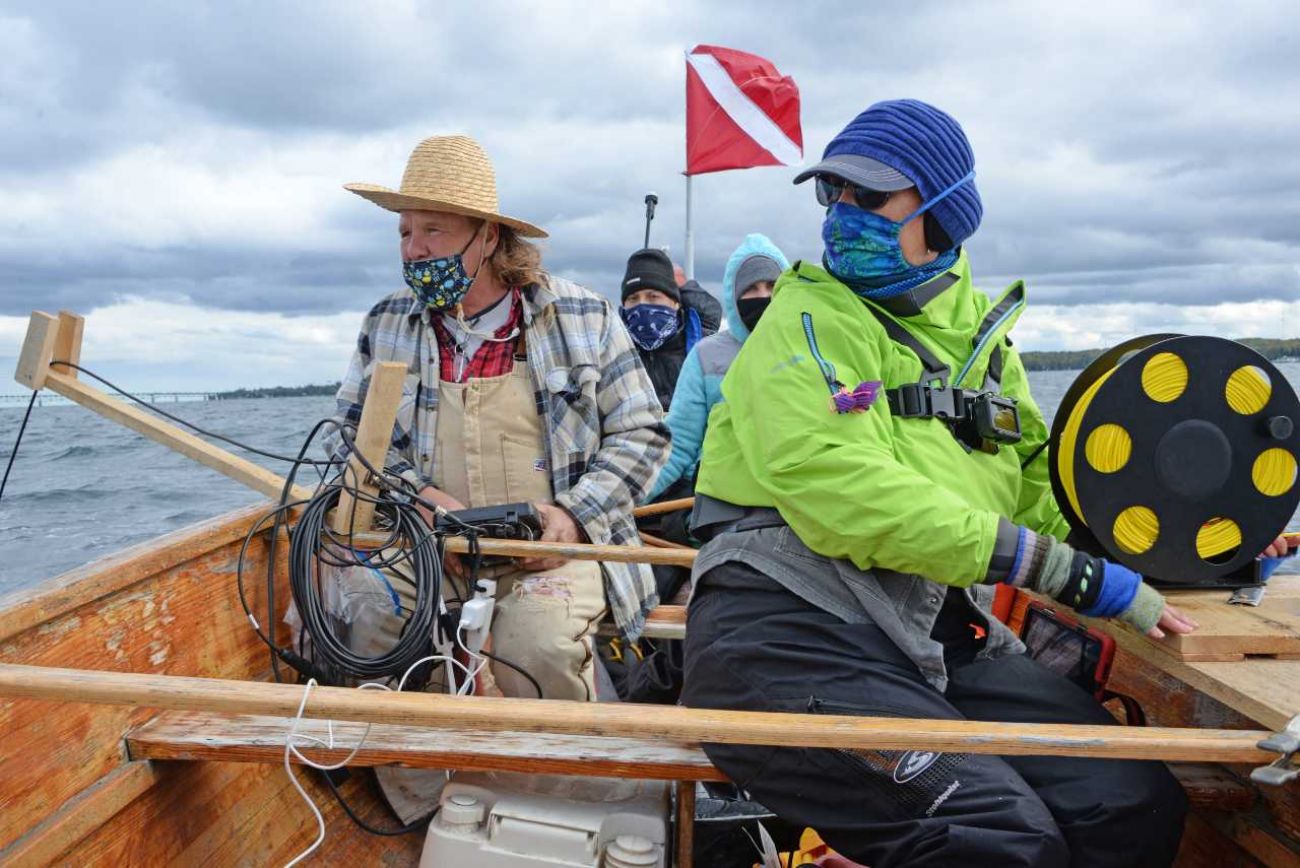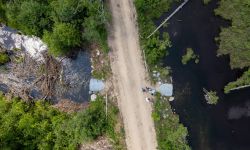After possible Ice Age discovery, group urges halt to Line 5 tunnel

As Michigan considers allowing Enbridge Energy to build a tunnel for its oil pipeline under the Straits of Mackinac, a group wants to halt the process, citing the possible discovery of archaeological artifacts near the pipeline.
The recent discovery, first reported by Detroit Free Press, was made by a group, most of them Native American women, looking to learn more about the dual-span petroleum pipelines Enbridge operates at the bottom of the Straits.
But as they paddled a traditional canoe and used a remote-operated underwater vehicle to explore the lakebottom, they discovered what they said may be an ancient cultural site from the Ice Age.
Related stories:
- Judge: Enbridge can resume full operations on Michigan Line 5 pipeline
- Enbridge just wants a permit. Michigan critics want to bring down Line 5
- 10 years later, Kalamazoo River spill still colors Enbridge pipeline debate
- Lawyers for Michigan argue to keep Enbridge Line 5 closed for safety
- Michigan regulator: Enbridge needs permission to move Line 5 into tunnel
The group said it also learned that state officials had been made aware in February of word that an Enbridge subcontractor noticed similar features in explorations in 2019, but was told to ignore them.
One member of the group behind the discovery said it raises new questions about Enbridge’s plan to replace its dual lakebottom petroleum pipelines with a single line encased in a concrete tunnel in the bedrock deep under the straits.
“They can’t go any further with that project until we find out how big this [possible cultural site] is and what it encompasses,” said Andrea Pierce, a member of the Little Traverse Bay Bands of Odawa Indians who helped organize the boat trips that led to the discovery this fall.
Pierce said she wants the state to halt consideration of Enbridge’s applications pending a tribally-led investigation into the discovery. She also wants to know what Enbridge knew, and when.
The Little Traverse Bay Bands of Odawa Indians are among many Michigan Native American tribes that had previously opposed Line 5. Members of the group involved in the archaeological discovery were operating as individuals, not as representatives of the tribe.
In a February letter to Martha MacFarlane-Faes, Michigan’s deputy state historic preservation officer, University of Michigan archaeologist John O’Shea contended that an Enbridge subcontractor had discovered evidence of a cultural site. The subcontractor was directed to ignore the finding and was later removed from the project, O’Shea wrote.
In the letter, O’Shea told McFarlane-Faes that the subcontractor with the firm SEARCH, Inc. found “linear stone alignments.” They were similar to Ice Age caribou hunting grounds O’Shea and Michigan Technological University professor Guy Meadows discovered in Lake Huron in 2009.
“This entire story is very disturbing,” he wrote, adding that the formations “are extremely vulnerable to disturbance and would be obliterated without a trace by the proposed tunneling.”
Enbridge denied that it knew about the formations. The company conducted a 2019 cultural assessment in the Straits and found no submerged cultural resources, company spokesman Ryan Duffy said.
“We have not seen the report from the organization suggesting they have discovered significant features and we do not know if they assessed the same areas we did,” Duffy said in an email. He said Enbridge is committed to protecting archaeological features as it pursues the tunnel project and “would welcome the opportunity to meet and talk with this group.”
The State Historic Preservation Office is reviewing Enbridge’s report, along with O’Shea’s letter, EGLE spokesman Hugh McDiarmid said. How and whether the possible archaeological find might influence EGLE’s eventual permit decisions will depend upon that review.
“We are awaiting their assessment and recommendations (if any), and that assessment will be factored into our permit decision,” McDiarmid told Bridge in an email. “EGLE has been and will continue to be diligent in ensuring Enbridge adheres to all regulations and requirements in their tunnel proposal.”
Pierce said she fears if Enbridge gets clearance to build the tunnel, vibrations during the drilling process deep underground could destroy the formations. She scoffed at Enbridge’s promise to protect archaeological features as it pursues the tunnel, noting that the company has not always been forthcoming about damage to its existing pipelines.
“Do we really want to take that chance?” She said. “This is a good part of our tribal history and culture we’re talking about.”
Michigan Environment Watch
Michigan Environment Watch examines how public policy, industry, and other factors interact with the state’s trove of natural resources.
- See full coverage
- Subscribe
- Share tips and questions with Bridge environment reporter Kelly House
Michigan Environment Watch is made possible by generous financial support from:
Our generous Environment Watch underwriters encourage Bridge Michigan readers to also support civic journalism by becoming Bridge members. Please consider joining today.
See what new members are saying about why they donated to Bridge Michigan:
- “In order for this information to be accurate and unbiased it must be underwritten by its readers, not by special interests.” - Larry S.
- “Not many other media sources report on the topics Bridge does.” - Susan B.
- “Your journalism is outstanding and rare these days.” - Mark S.
If you want to ensure the future of nonpartisan, nonprofit Michigan journalism, please become a member today. You, too, will be asked why you donated and maybe we'll feature your quote next time!






